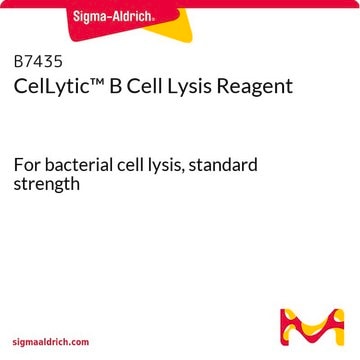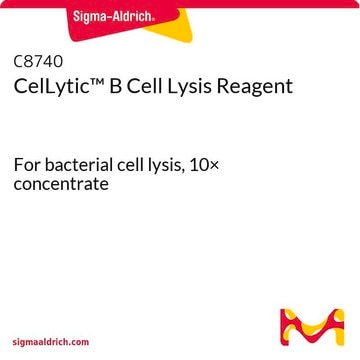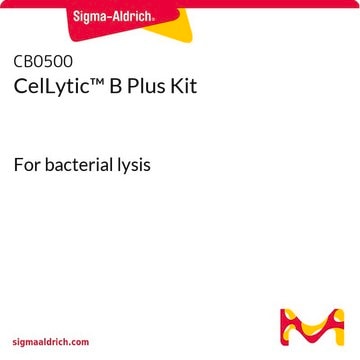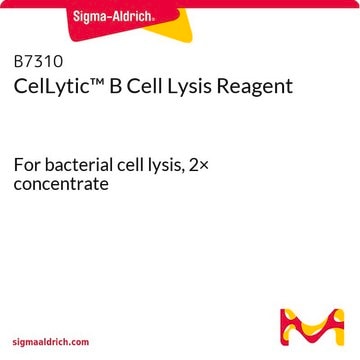The CelLytic B Lysis Reagent in this kit should not effect the nickel resin. Diluting the lysate supernatant should not be necessary, however, that depends on how much protein is being used.
CB0050
CelLytic™ B Plus Kit
For bacterial lysis
Synonym(s):
Cell Lysis Kit, Lysis Reagent
About This Item
Recommended Products
Quality Level
usage
kit sufficient for 5 g fresh or frozen cell paste lysis.
technique(s)
protein extraction: suitable
shipped in
wet ice
storage temp.
−20°C
Looking for similar products? Visit Product Comparison Guide
General description
Application
Features and Benefits
- Lyse Gram positive and Gram negative bacteria
- More efficient than sonication
- Compatible with affinity purification
- Isolate inclusion bodies for subsequent solubilization
- Non-denaturing cell lysis preserves protein function
Other Notes
Legal Information
Kit Components Also Available Separately
- B7435CelLytic™ B Cell Lysis Reagent, For bacterial cell lysis, standard strengthSDS
- E1014Benzonase® Nuclease, ≥250 units/μL, ≥90% (SDS-PAGE), recombinant, expressed in E. coli, buffered aqueous glycerol solutionSDS
- P8849Protease Inhibitor Cocktail, for use in purification of Histidine-tagged proteins, DMSO solutionSDS
- L3790Lysozyme from chicken egg white, 10 mg/mLSDS
Signal Word
Danger
Hazard Statements
Precautionary Statements
Hazard Classifications
Eye Irrit. 2 - Resp. Sens. 1 - Skin Irrit. 2
Storage Class Code
10 - Combustible liquids
Flash Point(F)
Not applicable
Flash Point(C)
Not applicable
Choose from one of the most recent versions:
Already Own This Product?
Find documentation for the products that you have recently purchased in the Document Library.
Customers Also Viewed
-
Is CelLytic™ B Plus Kit generally compatible with commonly used nickel resins for purification of his-tagged proteins? Do I need to dilute the lysate supernatant in my binding buffer before loading it onto my preferred nickel resin?
1 answer-
Helpful?
-
-
What is the difference between CelLytic B Plus Kits, Products CB0050 and CB0500?
1 answer-
Product No. CB0050 and CB0500 provide reagents sufficient for processing 5 g or 50 g of cell paste, respectively. Fewer grams of cell paste can be processed if proteins are to be extracted from inclusion bodies.
Helpful?
-
-
Can I concentrate my sample that was made using CelLytic B?
1 answer-
If concentrating a sample, be aware that concentration using filter concentrators may increase the detergent concentration significantly and cause issues in downstream applications. heoretically, ways to get around this are TCA precipitation, or diluting the extract below the CMC prior to concentration. This would be at least a 1/5 dilution, based on the following reference: Saito, S., and Tsuchiya, T., Characteristics of n-octyl beta-D-thioglucopyranoside, a new non-ionic detergent useful for membrane biochemistry. Biochem. J., 222(3), 829-832, 1984.
Helpful?
-
-
What bacterial cells can be used with CelLytic B?
1 answer-
CelLytic B Reagent by itself (no lysozyme or benzonase) was optimized for E. coli strain BL21. It also works with other common E. coli strains such as DH5?, JM109, and HB 101. The CelLytic B Reagent may be used on other similar bacterial cells. The CelLytic B Plus Kit is compatible with many more difficult to lyse Gram positive bacteria such as Bacillus and Streptococcus.
Helpful?
-
-
When using the CelLytic™ B lysis reagent, do I need to make a dilution prior to measuring protein by Bradford assay?
1 answer-
When using the CelLytic™ B lysis reagent (B7435, B7310, C8740, and contained in kits CB0050 and CB0500), it is best to use a 1:10 dilution in order to reduce the risk of interference with the Bradford Reagent. A 1:20 dilution would be even better, as long as the protein level remains within the standard curve.
Helpful?
-
-
What is the Department of Transportation shipping information for this product?
1 answer-
Transportation information can be found in Section 14 of the product's (M)SDS.To access the shipping information for this material, use the link on the product detail page for the product.
Helpful?
-
-
What is the difference between CelLytic B (Product Nos. B7435, B7310, C8740) and CelLytic B Plus (Product Nos. CB0050 and CB0500)?
1 answer-
CelLytic B Plus contains CelLytic B, Product No. B7435 as well as lysozyme, benzonase, and a protease inhibitor cocktail for a complete reagent for cell lysates for protein isolation.
Helpful?
-
-
Can I use the CelLytic™ B cell lysate in an activity assay?
1 answer-
CelLytic B contains a zwitterionic detergent so the protein is active and can be used in protein activity assays.
Helpful?
-
-
Can I use CelLytic B with the maltose binding protein system (MBP System)?
1 answer-
CelLytic B cannot be used with the MBP system. We have used this in the maltose binding protein system, and know that it will NOT work in this system, since any and all detergents will destroy binding of protein to the resin.
Helpful?
-
-
Can I obtain protein from inclusion bodies with CelLytic B?
1 answer-
If the protein is found in inclusion bodies, you need to use an additional reagent, Product No. C5236, CelLytic IB to solubilize the proteins from the inclusion bodies. CelLytic B is used to isolate the inclusion bodies from the bacteria. CelLytic IB, Product No. C5236 can then be used to solubilize the proteins from the inclusion bodies.
Helpful?
-
Active Filters
Our team of scientists has experience in all areas of research including Life Science, Material Science, Chemical Synthesis, Chromatography, Analytical and many others.
Contact Technical Service













